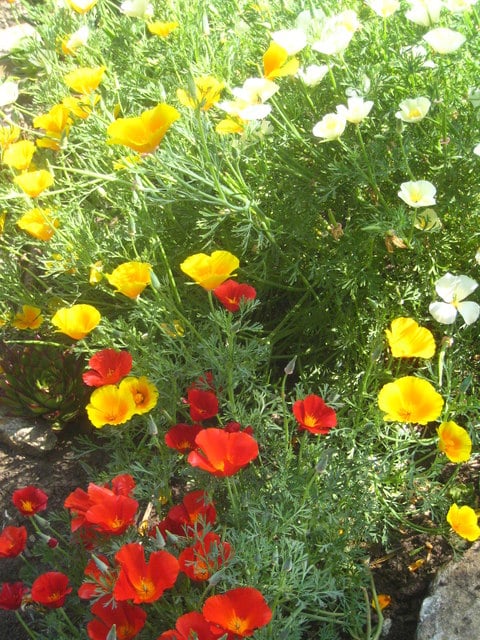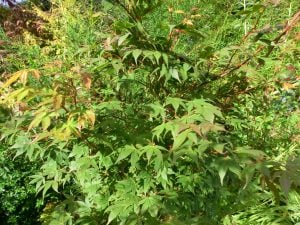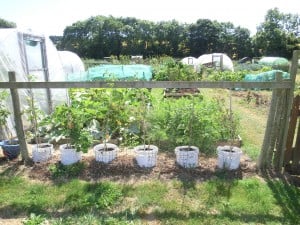Choose bedding plants for a bright summer display
The garden centres are full of summer bedding plants, tempting you to buy and plant to brighten up your gardens now the bulbs are mostly over. The late spring bank holiday is the traditional time for a bedding changeover.
In this post, we dig down (sorry!) for a little information to bring your summer garden a bit closer.

Holyhead Road, Coventry looking very colourful on 16 July 2008. © Amanda Slater and reused under https://creativecommons.org/licenses/by-sa/2.0/
What exactly are bedding plants?
Bedding plants are any plants (including bulbs and shrubs) that are planted temporarily in tubs and pots or in spaces in the garden. They give you a quick splash of flower and foliage colour, and when the flowers are over you just pull the plants out and replace them with something else. They aren’t only for summer, though. Bedding plants can give you instant impact in spring, autumn and winter too.
Now is the time to sow hardy annuals and, be quick, a few half-hardy annuals too
If you sow your own summer bedding you can try unusual varieties that aren’t generally available in garden centres and nurseries. And you’ll feel so accomplished! So, read on.
Outdoors, you can sow hardy annuals (HA on the seed packets) now where you’d like them to bloom. Prepare a clear patch of ground and fork the top few inches over. Rake it smooth. Draw out shallow rows (known as ‘drills’) of about a centimetre deep and sow thinly or broadcast the seed in a random scatter. Cover with a very thin layer of soil and press down lightly with your rake. Water in gently or let the rain do it, if it’s raining. Great hardy annuals include calendulas (English pot marigolds), scabious, love-in-the-mist, and nasturtiums. Californian poppies which have been flowering in profusion in the Californian desert this spring are another great choice. For more suggestions and more detailed sowing advice, look at the Royal Horticultural Society page here.

Californian poppies at Tremenheere Gardens, Gulval, Cornwall. © Rod Allday and reused under https://creativecommons.org/licenses/by-sa/2.0/
Some half-hardy annuals sown in April catch up very quickly with seed sown in March. We’re only just into May so choose dwarf varieties of French marigolds (‘Boy O’Boy’ or the Durango series) and modern dwarf zinnias (Zahara series), sow them and you’ll have flowers in June.
Choose your frost-tender summer bedding
Spread the pleasure of deciding: plan, prepare and look around now but only buy at the end of May, to be sure of missing any frost.
What to choose from such a wide array? In brief, anything compact, bushy or trailing is good. I also recommend thinking about how the colours fit together so they work for you, and your garden. Colour co-ordination suits some people; others are looking for a technicolour dream.
Pelargoniums and fuchsias give a long-lasting display of flowers. The ‘Cascade’ type of pelargonium, completely covered in narrow-petalled flowers all summer, is your best bet of reproducing those fantastic window boxes seen in the Alps and other parts of Europe.
Half-hardy annuals are frost-tender. Busy Lizzies and petunias, which can put on very long-lasting displays, are good for containers and hanging baskets. I prefer single-coloured petunias (plain red or deep blue) as I think they make a better display and fit in better with other flowers than the striped and blotched versions. And there’s lobelia, great for trailing from baskets and large containers.
What about Bidens? These trailing plants belong to the Aster family and are native to Central America. They have thin stems and creeping branches that reach 30-40 cm. Their leaves are sharply toothed and often hairy, and they have many numerous, five-petalled, yellow flowers.
For flowerbeds and gaps in the border, taller half-hardy annuals such as nicotiana, antirrhinums and cosmos are good.

Nicotiana 'Fragrant Cloud'. © cristina.sanvito and reused under https://creativecommons.org/licenses/by/2.0/
And don’t forget begonias and salvias. Nor Helichrysum petiolare, with silver-grey, felted leaves and grown for cutting or drying. You can grow it as a trailing plant or train it as a standard.
Get the bedding used to the Big Outdoors
The ready-grown bedding plants for sale in supermarkets, garden centres and nurseries have been raised somewhere warm and need to get used to outside conditions (‘hardening off’) before being planted out permanently. To do this, put plants in a cold frame or unheated porch for a few weeks before planting out when you’re sure you’ve had the last frost in your area. The centres of big cities are frost-free now and the rest of us should be OK after the end of May. Keep an eye on the weather forecast, though. Be on standby with sheets of newspaper, horticultural fleece (invest now?) or old net curtains to cover up your bedding plants if frost is forecast.
Planting out
Refill all containers with fresh compost. Any old compost will have run out of oomph some time ago, and it makes sense to give your bedding plants the best possible start.
Dig a hole in the compost or in the soil that's large enough for the rootball to fit comfortably.
Separate out plants, gently removing individual rootballs. Place in the hole, so the rootball’s compost is just below the level of the surface of the soil. Fill in the gaps around the plant with soil. Firm and water.
Caring for bedding plants
Bedding plants tend to be shallow-rooted so will need watering daily in the summer. Plants in containers and hanging baskets may need watering twice a day during dry weather.
Feed once a week.
Deadhead as blooms fade to keep plants tidy and to encourage new flowers.
For much more detail, have a look at the RHS page on bedding plants and displays.
It’s time to look forward to bright summer displays around front doors and on patios, in hanging baskets and flowerbeds.
Sign up for our emails below, so we can send you blogs on gardening tips, as well as updates on our sales, so you don’t miss out on those garden furniture bargains!









